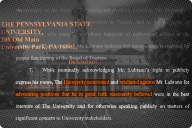You have /5 articles left.
Sign up for a free account or log in.
Some career updates: Mark Lamster, a Brooklyn, N.Y.-based author and lecturer, has joined the University of Texas at Arlington as a professor of practice in architecture. He has also been hired as an architecture critic for The Dallas Morning News. Finally, he will become a research associate at the David Dillon Center for Texas Architecture.
Sound overwhelming? Actually, the three posts are one job -- a joint hire by UT-Arlington and the Morning News. When both organizations realized they were looking to expand how they teach and cover architecture, respectively, they reached a novel conclusion: Why not hire one person to do it all?
The American University School of Communication and The Washington Post this month announced a joint hire of their own: the Pulitzer Prize-winning investigative reporter John Sullivan. Their partnership will be more interconnected than UT-Arlington’s agreement, as graduate students will get a chance to work in the Post newsroom to develop investigative reporting skills.
The idea that institutions of higher education and news organizations should join forces is not a new one, but the execution is. At a glance, the benefits of these partnerships are fairly obvious. On one hand, the institutions strengthen their faculty bodies with instructors who bring practical experience to their departments (the time-honored non-exploitive brand of "adjunct" professor). The newspapers, in turn, are able to expand the scope of their organizations after the financial crisis led many newsrooms to cut funding for arts coverage and investigative projects (among other things).
That professors with backgrounds in journalism would want to continue writing and reporting is no less surprising than a physics professor conducting independent research, but a joint hire splits these duties into somewhat independent careers -- and raises a handful of ethical and logistical questions.
Perhaps most obvious is the issue of time. Holding two positions means answering to two sets of expectations, catering to two distinct audiences and working with two groups of colleagues. Professors can structure courses to disperse their work, but breaking news can quickly throw plans into disarray. So far, the response to how the joint hires will manage their time boils down to, “We’ll see.”
“If college can’t be experimental and have a little flexibility, then nobody can,” said Donald F. Gatzke, dean of the UT-Arlington School of Architecture. “I think it’s going to be very synergistic.”
In Washington, Sullivan, the School of Communication and the Post agreed to the partnership only after the three parties walked away from their discussions confident they would all benefit equally.
“The determination was that if we could not satisfy the education requirements of the students and what American University hoped to accomplish..., what the Post wanted as far as producing stories and what I wanted, it wouldn’t work,” Sullivan said. “We’re going to have to work through whatever the challenges are to doing this well.”
Apart from their reporting duties, Lamster will teach one advanced seminar per semester that will meet twice a week, while Sullivan will help develop fellowship and internship opportunities.
“I think everybody is always worried about being spread too thin,” Lamster said.
For Lamster in particular, his position as architecture critic could also raise concerns about his objectivity. Bob Mong, an editor at The Dallas Morning News, said that much of the discussion about a joint hire involved hammering out the ground rules for Lamster’s employment, including the “innate conflicts” bound to arise should Lamster cover the expansion of the University of Texas System.
“I think they are definitely workable,” Mong said. “Because a lot of the North Texas colleges and universities are expanding and growing, it’s a good problem to have -- but how they grow, how they expand, that’s fair game.”
Based on the fanfare surrounding the joint hires, Sullivan said his affiliation with American University has been clarified well in advance of any potential conflicts -- although he said he doubts such a situation will occur in the first place.
“I just don’t see there being a lot of intersection between what I’m writing about and other institutions,” Sullivan said. “If a conflict were to arise, I think the Post is attentive enough to this relationship and professional enough that they would find a way to hand it off.”
American University’s agreement adds another twist: The joint hire is made possible through a grant from the Ford Foundation to the Post. The funding was not sufficient for a full-time hire, which led the newspaper to seek a partnership with the School of Communication, Sullivan said.
The foundation, which advocates for social change, has previously awarded grants to publications like the Los Angeles Times, a move perceived by some critics as an attempt to influence news coverage. The foundation declined to comment specifically on the issue of bias, but a spokesman said its grant to the Post gives the organization the freedom of how to invest the funds.
Despite these concerns, Lamster said “[looking] at the potential conflict is missing the grander picture” of the partnership. “They found a way to get Dallas an architecture critic that they didn’t have before. That’s tremendous. It would be nice if other cities and institutions could figure out how to similarly work together to bring broader art coverage to the public.”
Sullivan suggested the joint hires -- while still an experiment -- could be adopted by other institutions. “The students can be there with you as you move through a story,” he said. “These are partnerships. For the students to learn, it has to be a partnership.”








